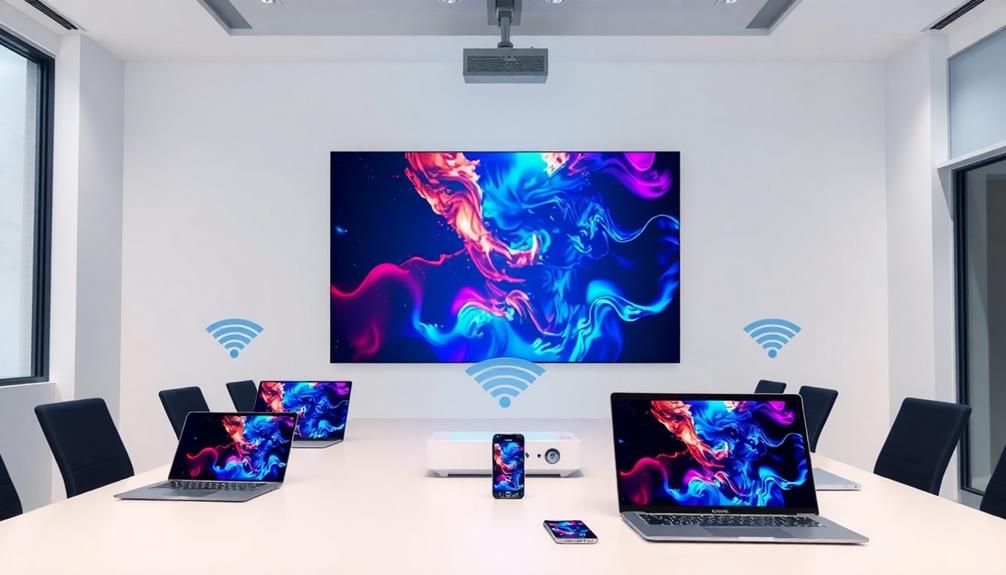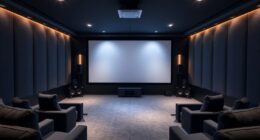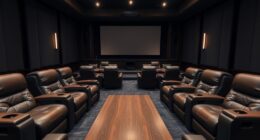Setting up an outdoor movie night is a fun way to enjoy films under the stars. Start with a quality projector, a large white screen, and external speakers for great sound. Don't forget to create cozy seating with blankets and pillows to keep everyone comfortable. String lights can add a magical ambiance, while snacks like popcorn and S'mores will keep guests happy. Plan your start time around sunset, and consider themed movie nights for added excitement. If you want to learn more tips on equipment and planning, you'll find plenty of great ideas waiting for you.
Key Takeaways
- Choose a quality projector with at least 2000 lumens and an appropriate screen for optimal viewing quality.
- Create a comfortable seating arrangement with a mix of chairs, blankets, and pillows for guest enjoyment.
- Use ambient lighting, like string lights or LED lanterns, to enhance the atmosphere without distracting from the screen.
- Start the film around sunset, allowing time for setup and socializing beforehand.
- Prepare a variety of snacks, such as popcorn and s'mores, to cater to different tastes and enhance the movie experience.
Essential Equipment for Viewing
When planning an outdoor movie night, you'll need the right equipment to secure everyone enjoys the experience.
Start with a quality projector; aim for one with at least 2000 lumens for clear visibility, but 3,000 lumens is ideal for brighter conditions. Pair it with a large, white projector screen or even an inflatable screen to guarantee the best picture quality, as projecting onto textured surfaces can lead to poor visuals.
Next, don't skimp on sound. Built-in projector speakers often fall short in larger gatherings, so invest in external speakers to enhance your sound system. This will keep everyone engaged during your viewing party.
Also, be mindful of power supply management. Use multiple extension cords to accommodate all devices, securing everything is powered up and ready to go.
Finally, conduct a test run of all your equipment before the event. This gives you the chance to troubleshoot any connection issues or performance glitches, guaranteeing a smooth viewing experience for your guests.
With the right equipment set up, you'll create an unforgettable outdoor movie night everyone will love!
Seating Arrangements and Comfort
When planning your outdoor movie night, think about the seating layout to guarantee everyone's comfortable.
Mix and match options like lawn chairs, bean bags, and picnic blankets to cater to different preferences.
Don't forget to add pillows and blankets for extra coziness as the night cools down.
Optimal Seating Layout
For an unforgettable outdoor movie night, arranging seating with intention is key to guaranteeing everyone enjoys the film. Position chairs, picnic blankets, or bean bags at a distance of 6-10 feet from the screen for ideal viewing, making sure each guest has a clear line of sight.
Consider incorporating multi-functional furniture options, like ottomans that can serve as both seating and storage for blankets or snacks, to enhance the experience. Mixing seating options enhances the cozy atmosphere—think patio chairs paired with soft outdoor rugs or plush picnic blankets.
To define seating areas, lay down outdoor rugs that not only create a comfortable surface but also add a touch of style to your outdoor movie theater. Keep seating away from direct pathways to minimize interruptions and allow guests to move about without disturbing others.
Adding cushions or pillows can greatly elevate comfort, especially as the evening cools down. This way, everyone can snuggle in and enjoy the film without any discomfort.
Comfort Enhancements Options
Everyone appreciates a comfortable setup during an outdoor movie night, so consider a variety of seating arrangements to cater to different preferences. For your backyard movie nights, mix lounge chairs, bean bags, and picnic blankets to enhance the viewing experience. This variety guarantees everyone finds a spot that suits their comfort preferences.
Additionally, providing some snacks, like safe snacks for hamsters, can enhance the overall atmosphere and enjoyment of the event.
To create a cozy atmosphere, lay down outdoor rugs that define the seating area and provide comfort underfoot. Scatter plenty of pillows and blankets around the space, allowing guests to stay warm and snuggly as temperatures drop in the evening. This not only adds a touch of style but also invites everyone to relax fully.
If you can, arrange seating in a tiered layout to assure an unobstructed view of the screen for all your guests. Utilizing outdoor cushions made from weather-resistant materials guarantees durability while offering a soft seating option, even in slightly damp conditions.
With these comfort enhancements, your outdoor movie experience will be inviting and enjoyable, making it a night to remember.
Lighting Options for Ambiance
Creating the right ambiance for your outdoor movie night hinges on effective lighting choices. The right lights not only enhance the cozy atmosphere but also guarantee your guests enjoy the movie without distraction.
Reflect on complementing your outdoor setup with some efficient tools like best vacuum models to keep the area clean and inviting. Here are some excellent lighting options to reflect on:
- String Lights: Hang these around your seating area or along fences. They provide soft illumination while creating a magical ambiance.
- LED Lanterns: Energy-efficient and portable, these lanterns offer soft lighting that won't overpower the brightness of your movie screen.
- Solar-Powered Walkway Lights: These budget-friendly options illuminate pathways, providing safety for guests maneuvering in darker settings.
- Dimmable Lights: Using lights that you can adjust allows you to control brightness levels as the sun sets, enhancing the viewing experience.
Don't forget to incorporate decorative elements like fairy lights or themed lanterns to complement the movie's theme.
These touches not only add to the overall aesthetic but also elevate the enjoyment of your outdoor cinema experience. With the right lighting, you'll set the perfect stage for a memorable movie night under the stars!
Timing Your Movie Night
Timing is essential for a successful outdoor movie night, so aim to start the film about an hour before sunset. First, check local sunset times for your event date, as these can fluctuate from around 5:30 PM in winter to 8:30 PM in summer. This way, you can plan your evening effectively.
Arrive early to set up your projector and screen, ensuring they're positioned correctly to avoid light interference from ambient sources. This setup not only includes the equipment but also allows for some socializing with your guests before the show begins.
Use a smartphone app or website to track sunset times and create a timeline that includes guest arrival, setup, and the start of the movie.
Don't forget to take into account the duration of the film and any intermissions you might want to include. This will help you prevent the event from running too late, especially for families with young children.
Snack Preparation and Ideas
Once you've nailed down the timing for your outdoor movie night, it's time to think about snacks that'll keep your guests satisfied and engaged. A well-prepared snack menu can elevate the experience, so consider incorporating the following ideas:
- Popcorn Station: Use a popcorn maker or a Whirley Pop to create fresh popcorn. Offer various flavorings like cheese, caramel, and butter for a fun twist.
- S'mores Station: Set up a S'mores station with graham crackers, marshmallows, and chocolate bars. Let your guests customize their treats during the movie.
- Candy Selection: Provide a diverse array of candy, including movie theater classics like M&Ms, Skittles, and Milk Duds. You can find these at local dollar stores for budget-friendly options.
- Snack Bar: Create a snack bar with nachos, Chex Mix, chips with dips, and pizza to guarantee a variety of choices for all attendees.
Don't forget to offer warm refreshments like hot apple cider or cocoa to keep everyone cozy on cooler evenings.
With these snacks, your outdoor movie night will be a hit!
Movie Selection and Themes
When it comes to selecting movies for your outdoor night, family-friendly films are a must to keep everyone entertained and avoid disturbing the neighbors.
Think about adding some fun themes, like a summer blockbuster lineup or a spooky Halloween horror night.
Engaging your guests in the selection process can make the experience even more enjoyable, so consider their preferences!
Family-Friendly Film Choices
Selecting the perfect family-friendly film sets the tone for a memorable outdoor movie night. To guarantee everyone enjoys the experience, aim for movies rated G or PG, featuring classics and newer hits alike. Here are some tips to guide your movie selection:
- Include animated films: Movies like "The Lion King" and "Frozen" are sure to delight kids and adults.
- Consider seasonal themes: Choose films that match the time of year, like "Hocus Pocus" for October or "Finding Nemo" during summer.
- Incorporate interactive elements: Encourage guests to dress as their favorite characters, adding fun and engagement to the night.
- Create a diverse lineup: Mix genres with family adventures, comedies, and animated films to cater to all ages.
Utilize online resources and community polls to gather suggestions from your guests, fostering a sense of participation in the movie selection process.
Themed Movie Night Ideas
Themed movie nights often elevate the outdoor viewing experience by adding an element of fun and excitement. You can create unforgettable memories by choosing films that align with specific themes.
For a "Summer Adventure" night, consider classics like "Jaws" or "The Goonies" to engage your audience fully. If it's October, embrace "Halloween Horror" with films such as "Hocus Pocus" or "The Nightmare Before Christmas," encouraging guests to dress up and immerse themselves in the festive atmosphere.
Another great option is organizing a "Family Favorites" night featuring beloved animated films like "Toy Story" or "Finding Nemo." This promotes family bonding and inclusivity, ensuring everyone enjoys the movie experience.
If you're feeling nostalgic, curate a lineup of nostalgic classics from the '80s or '90s, like "The Breakfast Club" or "Clueless," to spark shared memories among your guests.
Don't forget to incorporate interactive elements! Themed snacks, decorations, and activities that reflect the chosen movie can transform your outdoor theater into an immersive experience, boosting guest enjoyment and making the night truly memorable.
Budget-Friendly Setup Tips
Setting up an outdoor movie night doesn't have to break the bank; in fact, you can create a memorable experience for just a fraction of the cost. Here are some budget-friendly tips to help you enjoy a fantastic DIY Outdoor Movie night:
- Use a Large White Sheet: Instead of investing in an outdoor projector screen, grab a large white sheet or a shower curtain liner. It works wonders for achieving a clear image.
- Research Budget-Friendly Projectors: Look for projectors like the BenQ HT2060, which provides excellent performance at a competitive price, perfect for your outdoor setup.
- Collaborate with Neighbors: Team up with neighbors to share equipment, such as projectors and seating. This not only cuts costs but also creates a fun community vibe.
- Encourage Snack Sharing: Ask your guests to bring their own snacks and beverages. This way, you can all enjoy delicious popcorn and drinks while keeping expenses low.
Before you set your plans, remember to check the weather forecast to guarantee a perfect night to watch an outdoor movie!
Engaging Your Audience
Creating a memorable outdoor movie night hinges on how well you engage your audience. Start by utilizing social media platforms to create event pages where your guests can share their movie preferences and RSVP. This fosters excitement and builds anticipation before the big night. Conduct audience polls or surveys a week prior to gather feedback on film choices, allowing everyone to feel involved in the decision-making process.
Encouraging participation can enhance the experience considerably. Invite your guests to dress according to the movie theme or bring themed snacks. This not only adds a fun element but also makes the event more immersive.
To further engage your audience, consider setting up a comment section or live chat during the screening for real-time thoughts and reactions, creating a communal atmosphere.
Here's a quick reference to keep your audience engaged:
| Engagement Strategy | Description |
|---|---|
| Social Media Event Pages | Guests RSVP and share preferences |
| Themed Dress & Snacks | Enhances participation and immersion |
| Live Chat During Screening | Fosters a communal viewing experience |
After the event, solicit feedback through follow-up messages, gathering insights for future movie nights.
Backyard Preparation Steps
To guarantee your outdoor movie night is a hit, proper backyard preparation is key. Start by confirming you have clear weather conditions for a successful setup. Here are some essential steps to prepare your space:
- Check the weather forecast: Aim for clear skies and low chances of rain.
- Tidy the lawn: Remove any pet waste, branches, or leaves to create a clean and safe viewing area for your guests.
- Mow the grass: Do this a day before the event to minimize allergens and boost your backyard's appearance.
- Clear space for the projector setup: Remove garden decorations and trip hazards to confirm a safe environment.
Once you've completed the cleaning, send out invitations and set up any special decorations in advance. This will help create an inviting atmosphere for your movie night.
Frequently Asked Questions
How to Set up a Movie Night Outside?
To set up a movie night outside, you'll want to choose a projector, create a screen, arrange comfy seating, prepare snacks, and add some lights for ambiance. Don't forget bug repellent for a pleasant experience!
How to Set up an Outdoor Cinema?
How can you create an unforgettable outdoor cinema experience? Start by choosing a quality projector, setting up a smooth projection surface, and arranging cozy seating with snacks. Your guests will love the atmosphere you create!
How Do You Set up a Perfect Movie Night?
To set up a perfect movie night, you'll need cozy seating, tasty snacks, and a good selection of films. Create a welcoming atmosphere with soft lighting, and don't forget to take into account your guests' comfort!
What Should I Sit on for Outdoor Movie Night?
For an outdoor movie night, you'll want comfy seating. Use lounge or beach chairs for support, and don't forget cushions or blankets for extra comfort. Position everything for the best view of the screen.
Conclusion
As the sun dips below the horizon and the stars begin to twinkle, your outdoor movie night transforms into a magical escape. With cozy blankets wrapped around you and the scent of buttery popcorn wafting through the air, you've created a perfect setting for laughter and connection. By thoughtfully choosing your equipment and snacks, you've set the stage for unforgettable memories. So grab your loved ones, press play, and let the adventure unfold beneath the night sky.
Hello, I’m Art, and I’m excited to be a part of the 1Home Theatre Projector team. As a writer, I’m here to contribute my knowledge and insights to help you achieve the ultimate home cinema experience. I understand that making decisions in the world of home entertainment can be complex, and I’m here to simplify the process for you.
















